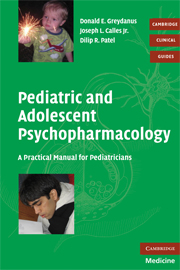Book contents
- Frontmatter
- Contents
- Contributors
- Foreword by Christopher K. Varley
- Foreword by Renée R. Jenkins
- Preface
- Acknowledgement
- 1 Principles of psychological management
- 2 The basics of pharmacology and neurotransmission
- 3 Basics of prescribing psychopharmacologic agents
- 4 Anxiety disorders
- 5 Attention deficit/hyperactivity disorder
- 6 Child and adolescent depression
- 7 Disruptive behavior and aggressive disorders
- 8 Schizophrenia in childhood and adolescence
- 9 Autism spectrum disorders
- 10 Psychotropic management of children and adolescents with cognitive–adaptive disabilities
- 11 Sleep disorders in children and adolescents
- 12 Tic disorders in children and adolescents
- 13 Substance abuse disorders
- Subject index
- References
11 - Sleep disorders in children and adolescents
Published online by Cambridge University Press: 18 December 2009
- Frontmatter
- Contents
- Contributors
- Foreword by Christopher K. Varley
- Foreword by Renée R. Jenkins
- Preface
- Acknowledgement
- 1 Principles of psychological management
- 2 The basics of pharmacology and neurotransmission
- 3 Basics of prescribing psychopharmacologic agents
- 4 Anxiety disorders
- 5 Attention deficit/hyperactivity disorder
- 6 Child and adolescent depression
- 7 Disruptive behavior and aggressive disorders
- 8 Schizophrenia in childhood and adolescence
- 9 Autism spectrum disorders
- 10 Psychotropic management of children and adolescents with cognitive–adaptive disabilities
- 11 Sleep disorders in children and adolescents
- 12 Tic disorders in children and adolescents
- 13 Substance abuse disorders
- Subject index
- References
Summary
Introduction
Human life can be divided into three specific stages of consciousness: wake, non-REM (rapid eye movement) sleep, and REM sleep (Table 11.1). The quality of life during the wakeful stage is heavily dependent on the quality of REM and non-REM sleep experienced, whether during childhood, adolescence, or adulthood. The most restorative sleep is delta sleep (slow wave sleep or deep sleep) that occurs in Stages 3 and 4 of non-REM sleep; it is during these stages that one is the most difficult to waken. Individuals waken during REM sleep, but the state of being awake is normally so brief that it is not recalled later when in the true wake state. Rapid eye movement and generalized muscle atonia are characteristic of REM sleep; diaphragmatic movements and erections are the only muscle movements not inhibited.
Sleep architecture changes from infancy to the adulthood years, and as children mature their sleep patterns begin to look more like adult patterns (Table 11.2). Such changes involve shorter duration of sleep, longer cycles of sleep, reduced requirement for sleep in the daytime, and less REM sleep (that constitutes half of sleep in newborns). Daytime napping is common in children 1.5–5 years of age and becomes less important in older children and adolescents unless there is interruption of normal nocturnal sleep stages. There is reduced total nocturnal sleep from infancy to late adolescence, and as adolescence emerges, there is a shift to later bedtime or sleep onset hour.
- Type
- Chapter
- Information
- Pediatric and Adolescent PsychopharmacologyA Practical Manual for Pediatricians, pp. 199 - 222Publisher: Cambridge University PressPrint publication year: 2008



